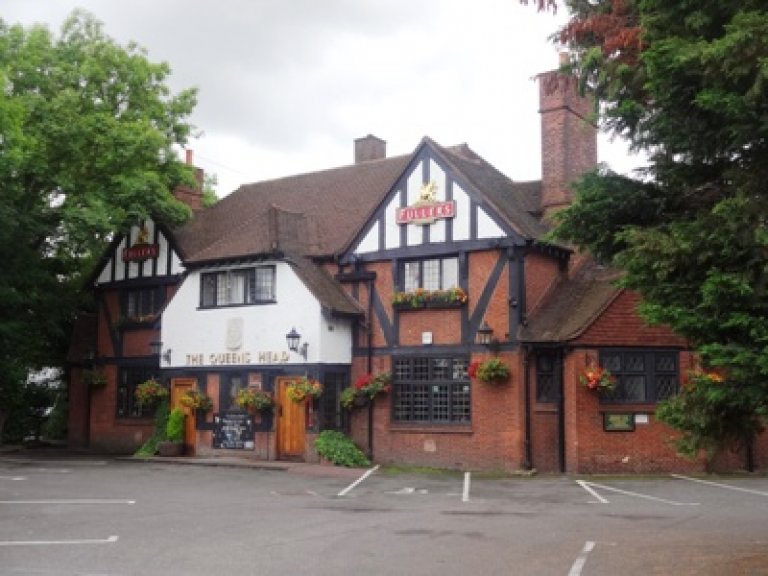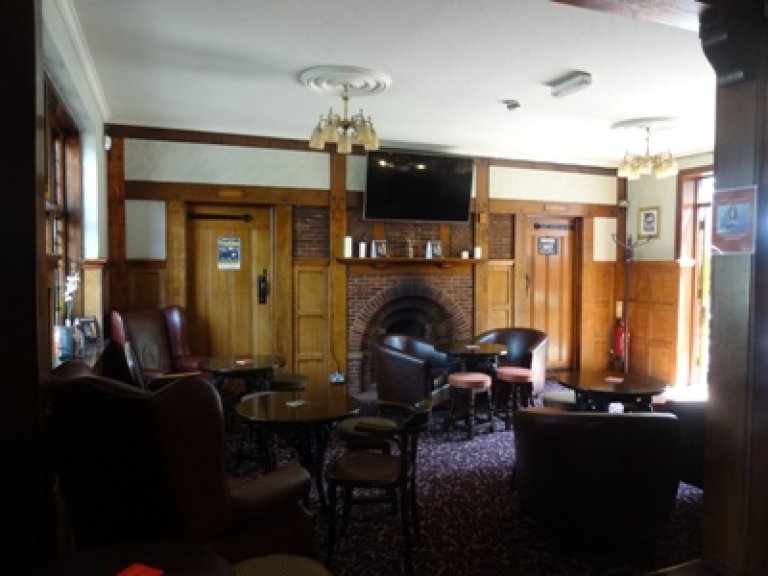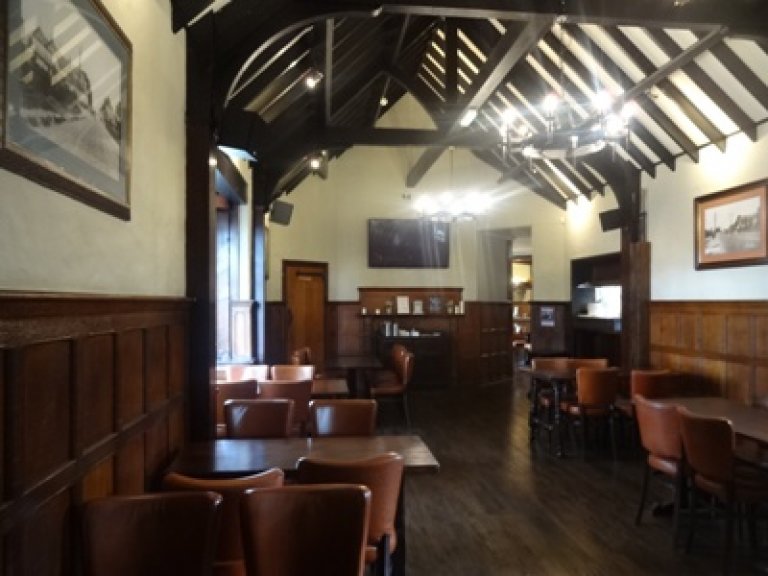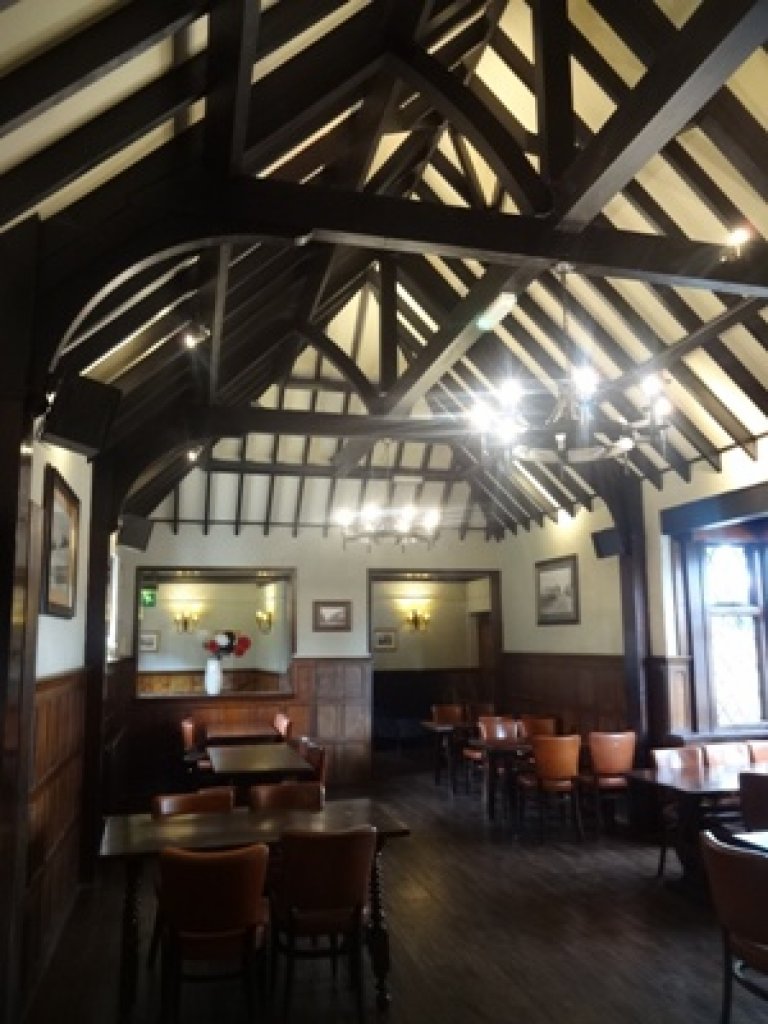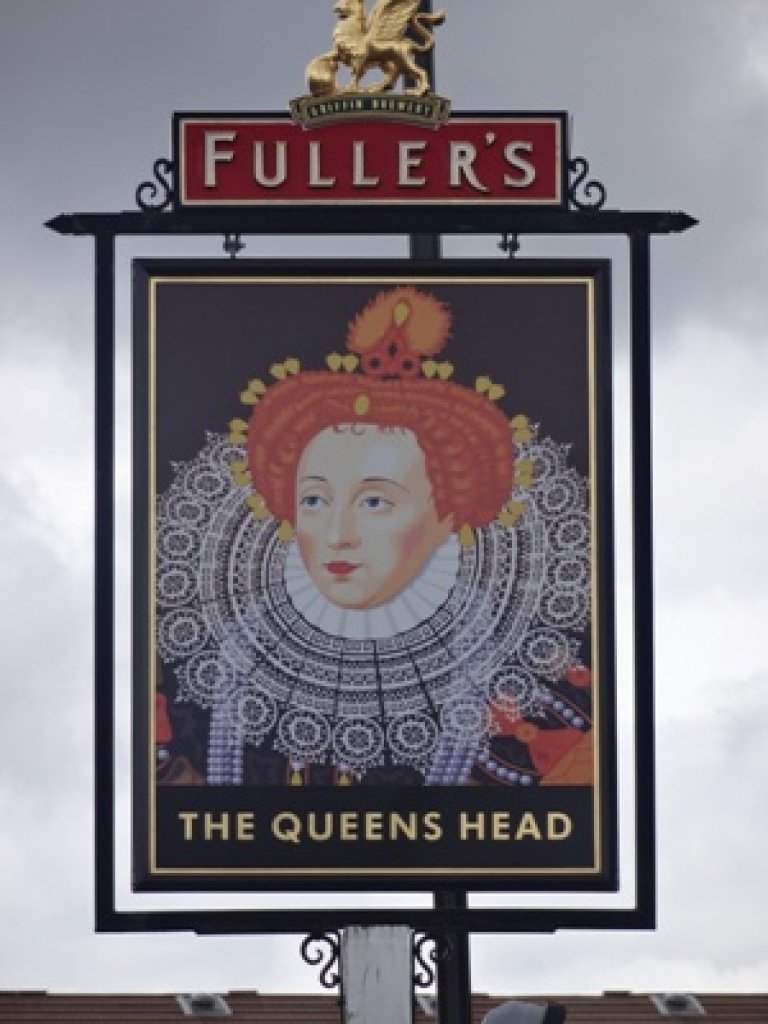Queens Head
123 High StreetCranford
TW5 9PB
This pub is not only a grade II listed building, it is also a Three Star pub on the Campaign for Real Ale’s (CAMRA) National Inventory with an interior of outstanding national historic importance, and the description is as follows: "This sprawling roadhouse pub, built in 1931 by Fuller’s, has a three-room interior that is exceptionally well preserved.
Two rooms – a public bar and a saloon – are separated by a central servery, and both are wood-panelled to half-height. The woodwork beneath the bar counter appears to be original. Leaded windows still have original 1930s mock-medieval metal clasps. Oak doors to the toilets are original and still have huge mock-medieval metal hinges and handles. (All toilets were updated with modern sanitary ware in the 2015 refit.)
The spectacular third room, the “Saloon Lounge”, is reached via a very short corridor, and its lofty proportions take the breath away as you step into it. It resembles a baronial hall with a high and open timber roof, and is reminiscent of a similar rear room at the Junction (formerly the Windsor Castle) in Battersea. At the rear of the saloon lounge is a small area, originally a store, which was brought into pub use in c.1977, which is the date of that area’s panelling and false timber joists.
There are original brick fireplaces in all three rooms, the central one being the grandest, having an attractive design which features four concentric brick arches, and being situated within an inglenook with a small fixed bench at either side. A rare concession to modern trends is the grey-painted panelling in the Gents toilet; mercifully this annoying habit hasn’t spread to the rest of the pub. A photo on one wall shows the pub that was on this site before it was demolished to make way for the current building.
The only significant change to the public spaces has been the creation of a connection between the public bar and saloon at the front of the pub.
Outside includes an arched entrance, with 1930s gates, through which small cars (and possibly even a few horse-drawn vehicles) would once have passed. The roof of the outhouse adjoining this (possibly once a garage or a stable) is now eye-catchingly covered in green moss. A stone carving of Queen Elizabeth 1st adorns the exterior – might it have been rescued from an earlier incarnation of this pub?
The original Queens Head dates back to 1604 and purports to be the first pub in England to be granted a spirits licence (a piece of imaginative thinking, one suspects!)."
The listing description is as follows: "Summary 'Improved' public house c1931, architect unknown, but possibly Melville Seth-Ward, for Fuller, Smith & Turner.
Reasons for Designation The Queen’s Head public house, Cranford, built c1931, possibly to the designs of Charles Melville Seth-Ward as an ‘improved’ public house for Fuller, Smith & Turner, is listed at Grade II for the following principal reasons:
* Architectural interest: an Arts and Crafts and Neo-Tudor pub on a historic site, with extensive use of good-quality materials and executed to a high standard of craftsmanship, the building exemplifies the character of the inter-war ‘improved’ public house; * Planning interest: the building’s layout of public rooms, of varying function and status, remains legible and illustrates a key tenet of the ‘improved’ typology; * Level of survival: the building survives very little-altered internally and externally, retaining its fireplaces, its oak joinery and leaded-light windows, door and window furniture and signage; * Architect and client: the building was designed for Fuller’s, a prominent Chiswick-based brewery, possibly by a notable architect.
History The present Queen's Head, built c1931, replaced an earlier pub of the same name that is said to have been built in 1604 and was certainly in existence by 1821. By 1851 it was in the hands of Fuller, Smith & Turner, the Chiswick-based brewery, founded in 1845. It stands on the corner of Cranford High Street and Cranford Lane in an area that until the mid-C20 was rural in character.
The first edition Ordnance Survey map for Middlesex (1874) shows that this earlier Queen’s Head was an irregular, elongated building aligned north-south. It stood slightly to the west of the present pub, fronting directly onto the High Street. Early C20 photographs show it as a modest, simple design, with a main double-storey block on the right (south), and a long, low range extending to the left (north); this seems to have included a stable and coach house.
The location of the rebuilt pub enabled the creation of a new road layout on the High Street side, providing a ‘draw in’ for customers - the brick planters within the car park appear to date from the 1930s; it was able to serve both locals and travellers using the nearby Bath Road, which has long been the major route west out of London. As a result of subsequent road changes the pub is now set back further than originally; in the 1960s the pub sign was mounted on one of two traffic islands separating it from the main road.
The pub’s new three-sided plan made the most of its corner site, and gave the building a closer relationship to Cranford Lane. It is possible that early plans for the nearby Berkeley Arms Hotel on Bath Road, designed by E B Musman and built in 1931-32, may have inspired the rebuilding of the Queen’s Head, although the latter does seem to be very slightly earlier in date than the Berkeley Arms.
The building's context has also changed since the construction in the 1950s of the Parkway (now the A312 or Hayes Bypass) which bisected Cranford High Street and divorced the pub from the centre of Cranford village. The road scheme was postponed by the advent of war, but in August 1939 the noted architectural firm Melville Seth-Ward and partners had prepared outline plans for Fuller’s illustrating a new Queen’s Head to be built on the north of Cranford High Street, a short distance west of the existing pub; the proposal is an interesting insight into Fuller’s concerns regarding the effect the new road would have on the Queen’s Head.
Charles Melville Seth-Ward FRIBA (1868-1946) is best remembered for his suburban and country houses, but also designed a number of pubs in London. These include the Albion Beerhouse, Hammersmith (c1925) and the Prince of Wales, Pimlico (c.1929) both for Courage & Co, and – especially relevant for the Queen’s Head - the Star on the Uxbridge Road, Hillingdon Heath (c1936, demolished) for Fullers and Co. It is highly possible that Seth-Ward was responsible for the Queen’s Head. Although the pub’s Neo-Tudor influence is not a form that is evident in much of Seth-Ward’s work, Neo-Tudor was of particular relevance here, given the name and history of the Queen’s Head.
Inter-war ‘improved’ or ‘reformed’ pubs stemmed from a desire to cut back on the amount of drunkenness associated with conventional Victorian and Edwardian public houses. Licensing magistrates and breweries combined to improve the facilities and reputation of the building type. Improved pubs were generally more spacious than their predecessors, often with restaurant facilities, function rooms and gardens, and consciously appealed to families and to a mix of incomes and classes. Central, island serveries with counters opening onto several bar areas allowed the monitoring of customers and also the efficient distribution of staff to whichever area needed service. Many, although not all, of the new pubs were built as an accompaniment to new suburban development around cities, and a policy of ‘fewer and better’ was followed by magistrates both in town and on the outskirts. A licence might be granted for a new establishment on surrender of one or more licences for smaller urban premises. Approximately 1,000 new pubs were built in the 1920s – the vast majority of them on ‘improved’ lines - and almost 2,000 in the period 1935-39. Neo-Tudor and Neo-Georgian were the favoured styles, although others began to appear at the end of the period.
Details Public house c1931, architect unknown, but possibly Melville Seth-Ward, for Fuller, Smith & Turner, in an Arts and Crafts and Neo-Tudor manner.
MATERIALS: soft red brick in Flemish bond, pegged timber frame with brick infill, some set diagonally, or rendered panels; plain tile roofs; oak fixtures and fittings.
PLAN: a main two-storey section with canted single-storey wings of unequal length to each side, resembling a butterfly plan, and with a two-storey service wing to the rear. The main section contains the public bar and saloon bar, with staff accommodation above and kitchens in the rear wing. To the south is a single-storey saloon lounge, with its own entrance, intended for sitting and eating as well as drinking. To the north is a covered carriage entrance and single-storey service range, including a garage, beyond it.
EXTERIOR: the main building is symmetrical in three main bays and two storeys. In the outer gabled bays the ground floor is in brick, the first floor and gable are timber-framed, infilled in brick, and rendered in the gables; these are framed by tall crisply moulded lateral stacks on the gable walls. Windows throughout the pub have ovolo-moulded oak frames, on the ground floor with four-light cross casements in on-edge flat brick openings with tile cills, and on the first floor with three-light casements, all with square-paned leaded lights.
The centrepiece is of one-and-a-half storeys, set forward beneath a half-hipped roof. On each side is an entrance – to the public bar and saloon bar - flanked by lozenge (diamond) pattern leaded margin lights; oak doors are framed and boarded with moulded muntins. In the centre is a lozenge pattern leaded window flanked by brick panels above a brick base. The gable above is rendered and lit by a single five-light casement window with square leaded lights, set high up under the eaves; set into the wall beneath it is a stone bust of Queen Elizabeth I, the name of the pub set out below. The main roof behind is hipped, and the central rear stack is visible above it.
To the right (south) is a single-storey saloon lounge. It is of brick, and as elsewhere in the building has oversailing rafters, the rafter feet exposed. Projecting square window bays have tile-hung gables, that to the left (the gents' WC) has a three-light cross-casement, the central bay has a four-light cross-casement bay window; both have lozenge pattern leaded lights. To the far right (south) is a taller entrance bay with a timber-framed rendered gable and a moulded panelled oak door and flanking windows as elsewhere in the building. On each face of the roof is a gabled ventilation louvre.
Offset to the left, on the corner of Cranford Lane, a projecting bay with a three-light cross casement (lighting both ladies' and gents' WCs), corresponding to the window to the gents' WC in the saloon bar. Beyond it is a covered carriage entrance that perpetuates the plan of the previous pub. Set into a single-storey brick wing it has a tile-hung gable, timber-framed rendered inner walls, and on the roadside a pair of framed timber doors with moulded panels, set in a bracketed frame. The rear, garden face of the attached wing has double, garage doors.
Rear windows are original casements with square or lozenge leaded lights except for the large inserted ground floor entrance to the public bar. The rear service wing has a rendered rear wall and deep catslide roof to the south over single-storey storage, and gabled dormer windows.
INTERIOR: the entrance doors lead left and right into the former public bar and saloon bar which are now united as a single space served by a central curved servery, but were originally separate rooms, each served by its own bar counter. The position of the former partition is clear from the remnant of the partition wall and ceiling and bar mouldings. Notable is the consistency of high quality oak fixtures and fittings, and the hierarchy of the bars denoted by their fireplaces. Throughout the ground floor the pub has oak three-quarter height panelling set in a pegged timber frame and the oak doors are framed, with four vertical panels with moulded muntins. Door furniture survives throughout, comprising ornate iron strap hinges, the lower hinge curved, the upper hinge embellished with a Tudor rose, shaped handles and latches. Windows have robust stays, catches and ornate plates.
All bars have round-arched brick fireplaces. In the public bar this is of three concentric arches with a brick hearth and set in a pegged timber-framed chimney-piece with a slender oak mantelshelf; the overmantel is inset with brick, set on the diagonal in the outer panels. To the left and right are entrances to the ladies' and gents' WCs (unusually both bars had facilities for ladies and gents). The saloon has an inglenook fireplace with a stone threshold. The inglenook is similarly timber-framed, the fireplace with four concentric arches. To each side is a fixed bench with curved ends. To the right is the gents' WC. The bar has a panelled oak front and softwood bar top. A later addition is a shallow canopy supported on pairs of square-based oak shafts; the bar back is similar. The single-storey saloon lounge has a braced king post roof which is made a feature of the room. It again has oak dado panelling, which rises above a single-arched brick fireplace with brick piers and a shallow moulded brick cornice, and a stone hearth. The bay window retains its fixed seating. The southern bay, the former entrance lobby, was altered in the 1970s, and is lined in softwood panelling. Within it is a ladies' WC.
Stairs to the first floor staff accommodation have square newels, rectangular balusters and a moulded rail. Some rooms have doors of three-over-three panels, some (one seen) have moulded fireplaces typical of bedrooms of the period.
All plant, kitchen equipment and services* are excluded from the listing."
The WhatPub link is here: WhatPub/Queens Head
The Pub Heritage Group link is here: PHG/Queens Head
The Queens Head has yet to feature on a LPG pub tour.
